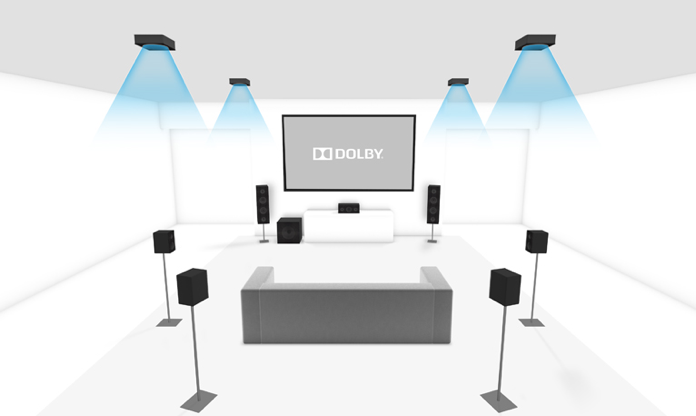Three Reasons to Buy Cheap Atmos Speakers
When Dolby introduced Atmos, they changed a lot about how to design and set up our home theaters. One of the biggest changes is the edition of overhead speakers. In their infinite wisdom, they assumed we’d all start installing in-ceiling speakers to accommodate their new surround sound format. We, of course, didn’t, but some companies came up with other solutions, and others found ways to mount our current speakers on the ceiling if we wished. While we might complain that overhead speakers are a hassle, Dolby at least had the foresight to realize that matching your main speakers was going to be problematic. That’s why your Atmos speakers don’t have to match your other speakers. This is great because you can buy cheap Atmos speakers and have a great Atmos experience! But why? Well…
Our Ears aren’t as Sensitive to Sounds Coming from Above

When you look at the shape of your ear, it is clear that it is shaped to capture sounds that are coming from in front of you. From the direction in which we are looking. Animals that want to hear a sound coming from another direction, move their ears. We don’t have the ability to do that.
But we’ve all experienced trying. Have a weird sound in your house? What do you do? Walk around putting your ear up to stuff. Sometimes it isn’t until you put your ear up to something and then move your head a bit before you can locate it. That’s because your brain is gauging the differences your two ears are hearing to locate the sound. If it is soft, or muffled, it is harder. Loud…not so much. Since we don’t have the ability to move our ears, we need to move our heads to accurately locate sounds that are coming from any direction other than in front of us.
Most Atmos receivers at this writing can decode up to two pairs of overhead speakers. There are fixed positions for these speakers with one pair in front of you and on the ceiling and one either above or behind you. In theory, you should be able to more accurately locate the sounds from the speakers that are closer to the front of the room. But you can’t. Why? Well…
Dolby Suggested Speaker Orientation

Dolby likely thought you’d use already installed in-ceiling speakers for Atmos. Because most of us have those, right? Note: I’ve never lived in a house that had in-ceiling speakers. It’s a weird assumption, but you can sort of see where they were going. Before, the placement recommendations had the side surround and surround back speakers placed very high. This had some people installing those speakers in their ceilings. Especially in homes in one of those planned communities.
We’ve been in so many of these with all of the speakers in the ceiling. It never sounded right.
But if you look at Dolby’s new guidelines, the base level of speakers is now supposed to be at or near ear-level. If you had speakers installed in your ceiling, you could add more speakers on the ground and convert the ceiling speakers to Atmos duty. They really wouldn’t be in the right locations but they’d be close enough. For the rest of us, we’re left trying to install speakers in the ceiling or buying Atmos speakers that we can mount where possible.
Beyond all that, in-ceiling speakers are, for the most part, designed to fire directly down. Nearly all of them. There are some that have tweeters that can be aimed, and others with built-in angles, but they are less common. Dolby, specifically said (PDF):
“If the chosen overhead speakers have a wide dispersion pattern (approximately 45 degrees from the acoustical reference axis over the audio band from 100 Hz to 10 kHz or wider), then speakers may be mounted facing directly downward.”
They do say you can aim speakers with narrower dispersion. But the directions are clear: The speakers should be pointed straight down. This means you are always sitting off-axis from the speaker and are likely experiencing a more diffuse sound. Diffuse sounds are harder to locate by design and therefore your Atmos speakers don’t need to match your main speakers. So spending a bunch on matching speakers isn’t necessary, which is great for someone that wants Atmos on the cheap. But, even if you wanted matching speakers, you’d have a hard time because…
Most Manufacturers Don’t Offer Matching Atmos Speakers

Lots of manufacturers make speakers. They may even offer a handful of different lines. Rarely, if ever, do they make in-ceiling speakers. When they do, they are almost never connected to any specific line. They are just their one in-ceiling offering (usually paired with an in-wall offering).
Speaker manufacturers realize the main use for in-ceiling speakers is distributed audio. Whole-house audio isn’t supposed to be easily locatable. Instead, distributed audio fills the space. It fills the house with music without drawing attention to where the sound is originating. If Dolby intended owners to use in-ceiling speakers, and in-ceiling speakers are generally designed for distributed audio, then they must have taken this into account.
What manufacturers don’t offer are Atmos in-ceiling speakers designed to match their other lines. Checking out the Klipsch website, their in-ceiling speakers are not listed with their Home Theater lines. They make reference to using similar drivers in some of their in-ceiling lines, but not anything about timbre matching.
If you think about the design of your main speakers and these in-ceiling offerings, it becomes clear why timbre-matching isn’t the goal or even possible. The big boxes in your room have completely different dimensions than these in-ceiling offerings. In-ceiling speakers can’t have the same sorts of dimensions as freestanding boxes. Even if they include backer-boxes, ceilings don’t have the room to recreate the space inside freestanding speakers.
With space limitations, in-ceiling speakers are always compromised. Without having complete control over how the speakers are installed, the manufacturers can’t make any claims about performance. That’s why you see lots of claims about better drivers, elements that can be aimed, EQ switches, price, and depth. They can’t tell you how they’ll sound in your room because they can’t control how you install them. Therefore they can’t timbre-match them to your other speakers. But that’s okay because…
This Actually Makes Atmos More Accessable
In the end, this is a good thing. Too often new technologies in home theater cause us to want to spend a bunch of money. This one of the few times that a new technology was announced and we are able to budget shop without fear of missing something. There isn’t that much super-important information coming out of your Atmos speakers. They are mostly used to add ambiance and some more specific overhead sounds. That’s why you can buy cheap Atmos speakers and have a great experience.


